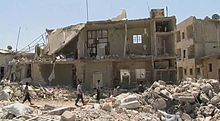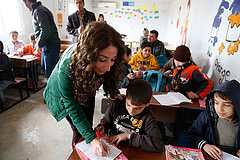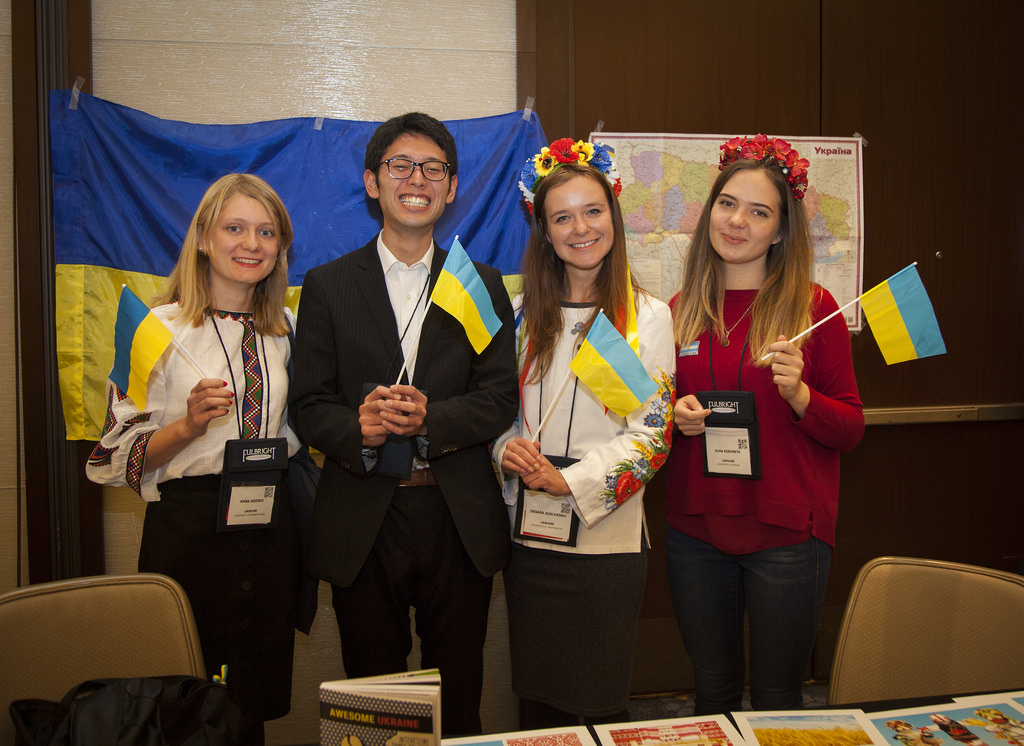Syria: The Unspoken Crisis
Despite widespread coverage in the mainstream media of the crisis continuing to unfold in Syria, there is very minuscule mention of its effect on education within the country. The current trends in analyzing the situation tend to focus on more mainstream topics such as possible military intervention scenarios or the unlawful use of chemical weapons. While these are all very important themes to address, another equally important, but largely disregarded, is that of the refugee crisis and the wars brutal effect on education within the country.
Though unbeknownst to many in the West, there are currently a handful of organizations researching the effects the war is having on education in Syria. Many of these organizations are also advocating for basic protections of schools, children, educators and the right to education itself. The specific article I have focused on to better analyze the situation, titled Safe No More, was published by the Human Rights Watch. However, apart from this organization, in keeping up with the situation in Syria, I have come across reports from many other organizations as well, such as UNICEF, Amnesty International, and the United Nations.
In this analysis, a neutral standpoint will be taken by not favoring any one side of the warring factions over the other. The situation here, in the context of Human Rights and Peace Education, is not in regards to either conflicting side specifically but rather to the children caught in the middle. As the Human Rights Watch report explains, “All parties to the armed conflict in Syria have used schools for military purposes […] both after students had ceased to study there and, in some cases, while they continued to attend lessons” (Motaparthy, 2013).
While abstaining from taking sides in the conflict, however, it is nonetheless important to note that while the armed opposition has not really had the means to take part in, or be a signatory of, past international conventions, the Syrian government indeed has. Syria, thus, can be held more accountable for going against treaties and conventions that it is a party or signatory to. The Syrian government has adopted the Universal Declaration of Human Rights (UDHR), for example, and is also a party to two international treaties that establish the right to education under international law (Motaparthy, 2013). In Teachers and Human Rights Education, the authors mention “the most powerful instruments are conventions and covenants, since […] signatory governments are legally bound to observe their provisions” (Osler & Starkley, 2010, 36).
While easier to point blame at the actual government due to its constant and evident breaching of conventions and international declarations, Human Rights Watch calls on both sides of the conflict to immediately halt all actions that are damaging to or hindering the right to education. Specifically it recommends that both parties should:
- Not deploy forces, weapons and ammunition, or material in or near schools where this would place students, teachers, and other civilians at unnecessary risk.
- Where schools are used for military purposes, work with civilian authorities to ensure that children are immediately relocated and able to continue their education in a separate and safe location. (Motaparthy, 2013)
The amount of violations of international law concerning the right to education and security are staggering. Both sides of the conflict have been using schools for military purposes, thus establishing these centers of education as legitimate military targets under the laws of armed conflict and putting educators and students in direct danger. Under current conditions, there is an absolute lack of feasible protections for education and the civilians involved. Witnesses have described that the “authorities [have] sent security officers and used school officials to interrogate students about their political views and alleged anti-government activities by students and their parents” (Motaparthy, 2013).
In accordance with witness testimony, there is an obvious hidden curricula being utilized in favor of the government of president Bashar al-Assad and against the armed opposition. This use of hidden curricula is detrimental, at best, in terms of there ever being a possibility of easy reconciliation and coexistence between the opposing populations within the country. Due to this hidden curricula and intimidation tactics currently being employed in schools throughout Syria, enrollment rates have plummeted. In March of 2013, UNICEF reported that only 6 percent of children [in Aleppo] could attend school (Motaparthy, 2013). The article also mentions that “since the start of Syria’s internal conflict in March 2011, school and universities have become charged political sites in which government authorities have monitored, threatened, and sometimes physically assaulted students critical of the Assad government” (Motaparthy, 2013).
More extensive and in-depth research will need to be conducted to find out what exactly is happening to the children who are being denied education due to this conflict. This research will need to employ various methodologies and be conducted over a long span of time, including well after the cessation of hostilities. For now, current ideas of what the long-term effects will be can only be estimated. However, Human Rights Watch has included some early findings in its reports stating that students who had to leave school because of the conflict have become child laborers, child soldiers, or helpers for the armed opposition. Girls have had to marry for economic need or for lack of other safe options (Motaparty, 2013).
On a somewhat more optimistic note, the article does mention that “as schools have become too risky for students to attend, communities and activists across the country have started informal community schools or clandestine learning programs” (Motaparthy, 2013). These efforts at schooling children despite all odds can, as discussed in Educating Children in Conflict Zones, help shape children’s well-being. However, as the authors go on to point out; these “makeshift” schools, while indeed beneficial, most often suffer from inadequate resources (Mundy & Dryden-Peterson, 2011).
Once this tragic situation begins to abate and is finally resolved, education will be vital to improving the lives of those who have been denied human rights and the basic freedoms of security, liberty, and peace. Hidden curricula that promotes hate and stifles dialogue will need to be effectively abolished. Bajaj points out that “critical peace education has an important role to play in situations where interethnic conflict is rife and where human rights abuses have occurred” and goes on to highlight that it is crucial to promote understanding and harmony between conflicting sides by prioritizing “even-handedness in its treatment of perpetrators and victims of human rights violations as targets of peace education” (Bajaj, 2008, 140).
The goal of incorporating Peace and Human Rights education into the Syrian post-conflict curriculum is going to be challenging yet imperative. Reardon mentions that the “conceptual core of peace education is violence, its control, reduction, and elimination. The conceptual core of human rights education is human dignity, its recognition, fulfillment, and universalization” (Reardon, 1997, 22). These very concepts will surely be beneficial to the children and educators in a post-conflict Syria.
In Peace Education, A Review and Projection, Betty Reardon mentions the differences between education for and education about peace. She argues that, and I think agreeable in the context of a post-conflict Syria, that it is education about peace that is “essential peace education”. This idea defines education about peace as a platform that addresses what peace is, its essence, and it assumes that without knowledge of what it comprises peace can not be pursued, much less achieved (Reardon, 2000, 403). Education about peace incorporates both human rights education and conflict resolution, according to Reardon, and both of these, along with traditional peace education, are concerned with “avoiding, reducing and eliminating violence” (Reardon, 2000, 403).
In a post-conflict Syria there will be a need for dialogue within schools and, with it, human rights education for co-existence. Conflicting sides will need to be brought together under a curriculum enabling all to see the other side’s point of view and that there are many ways to live peacefully within a nation and the global community at large. In a report titled The Politics of Participation when Educating for Co-Existence, the author Maria Hantzopoulos explains that, “while such co-existence initiatives often vary in scope and mission, most share a common aim and purpose: to facilitate dialogue among members of the identified conflicting groups in the hopes of eventually attaining peaceful reconciliation” (Hantzopoulos, 21).
Human Rights Education for Co-Existence has been effective in the past when implemented in a post-conflict situation and will clearly be one of the many types of Human Rights and Peace Educations that will need to be implemented in Syria. As Bajaj mentions in an article titled Human Rights Education: Ideology, Location, and Approaches published in the Human Rights Quarterly, “this approach emphasizes the role of minority rights and pluralism as part of the larger human rights framework. […] Values and skills may be related to conflict transformation, respect for differences, mutual understanding, and dialogue” (Bajaj, 2011, 492).




Regardless of the outcome of the crisis, when the dust of war finally settles and an outcome can be established, however loosely it may be, human rights and peace education must play a vital role in reducing post-conflict hostilities in the country. Children, in many cases, will be very below the average literacy levels for their ages and will need to be brought up to speed quickly. International organizations must make efforts to ensure that there is no hostile hidden curricula being taught in schools. Dialogue, as shown to be effective in other parts of the world, will need to be established with concrete aims of settling remaining disputes between opposing populations.
Violence, described by Betty Reardon as “intentionally inflicted harm that is avoidable and unnecessary to the achievement of just and legitimate purposes” (Reardon, 2000, 404) is one of the most frequent impediments to education the world over. Whether direct violence or structural violence; educators all over the world can, and should, learn something from each world crisis that affects education.
Be it war in Iraq or Syria, armed groups attacking schools in Afghanistan, utter poverty in Guatemala and India, or even bullying and gun violence here at home, the right to a secure and fulfilling education is greatly challenged around the globe by many forms of violence. In every great calamity, however, if looked at with the right perspective, a positive light can be born. One can only hope the positive light that may shine out of these many crises can bear witness to the development of new and ever-improved strategies in Peace and Human Rights Education.
By Paul Downey
References
Bajaj, M. (2008). Critical Peace Education. In Bajaj, M. (Ed.), Encyclopedia of Peace Education, (pp. 135-146). Information Age Publishing.
Bajaj, M. (2011). Human rights education: Ideology, location, and Approaches. Human Rights Quarterly, V 33, No 2, (pp. 481-508). The Johns Hopkins University Press.
Hanzopoulous, M. (2011). Encountering peace: The Politics of Participation when Educating for Co-Existence. In Trifonas, P. P., & Wright, B., (Eds.), Critical issues in Peace and Education, (pp. 21-39). Routledge.
Motaparthy, P. (2013, June 6). Safe No More: Students and Schools Under Attack in Syria. Human Rights Watch. Retrieved from http://www.hrw.org/reports/2013/06/06/safe- no-more.
Mundy, K. E., & Dryden-Peterson, S. eds. (2011) Educating Children in Conflict Zones: Research, Policy, and Practice for Systemic Change : A Tribute to Jackie Kirk. New York and London: Teachers College Press.
Osler, A., & Starkey, H. (2010). Teachers and Human Rights Education. Stoke-on-Trent: Trentham Books.
Reardon, B. (1997). Human Rights as Education for Peace. In Andreopoulos, G. J. & Claude, R. P. (Eds.), Human Rights Education for the Twenty-First Century. (pp. 21-34). University of Pennsylvania Press.
Reardon, B. (2000). Peace Education: A Review and Projection. In Moon, B., Brown, S., & Ben-Peretz, M., (Eds.), Routledge International Companion to Education, (pp. 397- 425).







Love that you turned your paper for EDF 6852 into a Blog Post. That’s awesome Paul!! Nice references too 🙂 Dr. G